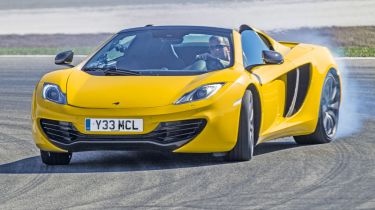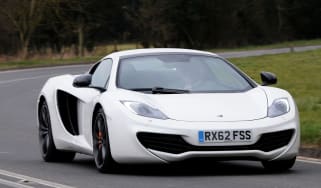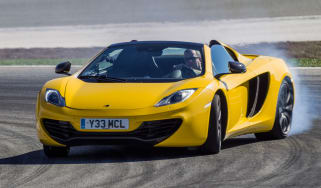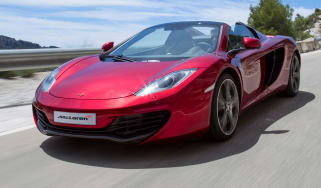McLaren 12C Spider (2012-2014) review
The McLaren 12C Spider convertible is powered by a 616bhp V8 engine that propels it from 0-62mph in 3.1 seconds

The McLaren 12C was designed as a coupe and a Spider convertible from the outset. As a result, the 12C’s carbon fibre MonoCell chassis requires no strengthening of any kind to retain its rigidity with the roof removed. As it's just 40kg heavier, the Spider’s performance is identical to that of the coupe, plus there’s absolutely no dynamic compromise. The clever glass rear screen can be lowered on its own, allowing you to savour the V8 soundtrack, while with the roof down it doubles as a windbreak. Designed to rival the Ferrari 458 Spider, the McLaren is every bit as desirable.
Engines, performance and drive
Few cars can rival the performance and handling of the 12C Spider. In line with the 2013 revisions to the 12C coupe, the mechanically identical Spider benefits from a revised 616bhp engine (up from 592bhp), while reworked software sees faster and smoother gear changes. There’s so much power on offer throughout the rev range and the throttle response is so urgent that there’s hardly ever a need to push the engine hard, but an improved soundtrack means you’ll want to. Acceleration from 0-62mph takes 3.1 seconds, while 0-100mph takes a scarcely believeable 6.1 seconds. The hi-tech suspension delivers amazing body control, masses of cornering grip and a surprisingly supple ride.
MPG, CO2 and Running Costs
Clearly this isn’t a cheap car to run. McLaren claims average economy of 24.2mpg, which means fuel bills will be hefty. But given the colossal performance on offer, the 12C Spider is relatively efficient – emitting 279g/km of CO2. Unlike Ferrari, McLaren doesn’t offer free servicing deals but its global dealer network is growing. Depreciation is one of the largest cost factors with expensive cars but the McLaren’s exclusivity means that residual values are pretty good.
Interior, design and technology
The McLaren 12C Spider looks every bit as good as the coupe. In fact, from some angles you’d be hard pressed to notice any differences. The sloping rear screen is gone, replaced by a flat cover and a pair of large buttresses, although unlike the Ferrari 458 Spider, a small section of glass still allows a glimpse of the V8 engine. The two-part roof is neatly incorporated in the design and when folded it’s completely hidden beneath the clamshell cover.
Practicality, comfort and boot space
Don’t be fooled into thinking a manufacturer like McLaren doesn’t care about practicality. Uniquely to the 12C Spider, when you don’t fancy wind-in-the-hair motoring, the roof storage area can be used as an extra luggage space – with 52 litres of space in a pair of bespoke bags. The nose boot has 144 litres and cabin space is excellent, while the steering wheel and pedals are perfectly placed, meaning the driving position is spot on. Visibility is excellent for a supercar, too, while an optional nose lifter makes it easy to get into car parks.
Reliability and Safety
Just as in Formula One, the McLaren’s super-strong carbon-fibre tub acts as a survival cell for occupants. The pair of rear buttresses contain a steel structure to absorb impacts and provide rollover protection. The carbon-fibre cell is so strong that it needs no strengthening with the roof removed, and all of the 12C crash tests were carried out on a roofless chassis. The car's traction and stability control systems are superb and there’s the option to add ceramic brakes.







